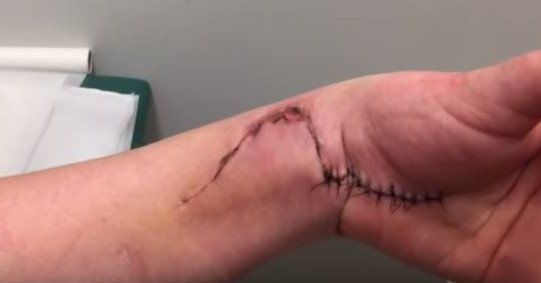Carpal Tunnel Syndrome Surgery
From Dr. Z - Carpal tunnel syndrome specialist
Carpal Tunnel Syndrome Surgery
Carpal tunnel syndrome surgery is an operative procedure used by doctors to treat severe symptoms of carpal tunnel syndrome. It's technically called "carpal tunnel release surgery".
This hand operation is performed in a surgical setting like a hospital or surgical center, not a doctor's office. If there are no surgical complications, it does not require an overnight stay in the facility.
This article describes the 2 main types of this procedure (open and endoscopic). It also describes:
- When you need carpal tunnel syndrome surgery
- Preparing for carpal tunnel syndrome surgery
- Description of each surgical procedure
- Pros & cons of each surgical procedure
- Recovering from surgery, post-surgical pain, and aftercare
- Factors affecting your recovery time
- Success rate of carpal tunnel syndrome surgery
- Risks of carpal tunnel syndrome surgery
When you need carpal tunnel syndrome surgery
Not everybody is a candidate for carpal tunnel syndrome surgery. Sure, the numbness or pain in your hand and fingers may be driving you crazy. But that's usually not enough for a doctor to operate on you.
The American Academy of Orthopedic Surgeons recommends 2 major steps for fighting this disorder.
Step 1.
The doctor must
confirm
your symptoms are due to carpal tunnel syndrome. Other disorders (like
tendonitis or
rheumatoid arthritis) can show similar symptoms.
Step 2. Once carpal tunnel symptoms are confirmed, the doctor must FIRST try and treat it without surgery. That's because non-surgical methods work about 77% of the time. But if all non-surgical methods fail, then surgery is recommended.
- FIND OUT: do you have carpal tunnel? No strings attached self-test.
Criteria for having carpal tunnel syndrome surgery
Now let's say your doctor determines you have carpal tunnel syndrome. And for several months you and your doctor have tried all available non-surgical methods without success.
Then your doctor will determine if you are a good candidate for carpal tunnel syndrome surgery. This means you must meet the following criteria. While there are some exceptiions, the patient must:
- Be confirmed with EMG and nerve conduction tests to have carpal tunnel syndrome.
- Have severe pain or numbness for several months.
- Have tried all other non-surgical remedies without success for at least 6 months.
- Be less than 75 years old.
- Not be pregnant.
- Not be obese or a smoker.
- Not have an infection or another severe illness.
Preparing for carpal tunnel syndrome surgery
Before the day of surgery
Stop smoking
Being obese and/or a smoker does not automatically disqualify you for having carpal tunnel syndrome surgery. And going from obese to normal weight in a couple months is not usually attainable.
However, you CAN do something about smoking.
Smoking affects how fast you recover from any surgery, and reduces the risks of complications. Smoking tobacco constricts blood vessels and therefore restricts healing. It also plays a role in how well your surgical scar heals. Finally, symptoms of carpal tunnel syndrome worsen if you smoke.
Your doctor should advise you to stop smoking 2-4 weeks before the surgery. You should also refrain from smoking for another 2-4 weeks after surgery. These measures help insure your carpal tunnel syndrome surgery proceeds without complications and your recovery is fast.
Stop taking some medicines
Be certain that your doctor is aware of every medication you take. That's becasue some medicines could adversely affect your operation. Therefore, some medicines may be temporarily discontinued between 3 and 14 days before the opertation.
The most common medicines you should discontinue are those which inhibit healing or promote bleeding. Such drugs include:
- Blood thinners (Coumadin, Plavix) usually discontinued 3-4 days before surgery.
- Nonsteroidal anti-inflammatory drugs (aspirin, Advil, Motrin, Aleve) usually discontinued 7-10 days before surgery.
Limit your foods and drinks
Do not eat or drink anything after midnight before your carpal tunnel syndrome surgery. You can drink a little water to take the approved morning medicines.
The reason food and drinks are discontinued before the operation is simple. Anesthesia shuts down most of your body's reflexes. If your stomach contains liquid or food, you could vomit into your airway.
On the day of surgery
Your surgical facility will be either a hospital outpatient service or a stand-alone surgical center. When you arrive and fill out the appropriate forms, you will change into a hospital gown. (So before leaving home, dress casual, and don't take anything fancy or hard to remove.) Leave your valuables and jewelry at home.
You will be in the pre-op area and given a pill or injection to ease your anxiety. You must remove eyeglasses, dentures, contact lenses, hearing aids, and piercings. Then you will be transferred to the operating room.
Right before the operation begins you will either receive general anesthesia or a nerve block. General anesthesia will put you into a light sleep. With a nerve block, you will be awake but you won't feel anyting happening on your hand.
Depending on which surgery you have (see below), you will be in the operating room for 20-45 minutes, assuming no complications arise.
Description of each surgical procedure
There are 2 basic types of carpal tunnel syndrome surgery. They are called open and endoscopic carpal tunnel release surgery.
Also, there are 2 basic types of endoscopic carpal tunnel release surgery. They are called single or double portal endoscopic carpal tunnel release surgery.
Your doctor will decide on which operative procedure you will have. That's because doctors prefer to use the procedure they are most skilled with.
Open and endoscopic technique have their own advantages and disadvantages. These are called pros & cons, and are discussed in greater detail below. The below side-by-side comparison outlines the key differences between the two surgical techniques.
Open carpal tunnel release surgery
Open carpal tunnel release surgery requires the doctor to make a 2 to 3 inch long incision in your palm. Then the doctor slices a ligament between your wrist bones together. This causes the bones to separate. And this process relieves pressure on the
median nerve below the ligament.
Endoscopic carpal tunnel release surgery
Endoscopic carpal tunnel release surgery means the doctor tries to cut the ligament just like in the open technique above. But instead of a long skin incision, the doctor uses an endoscope. The endoscope is a thin tube with a miniature camera at the end so the doctor can see deep inside your wrist joint.
The endoscope is inserted into the wrist through a small hole in your skin. Usually, a different narrow tube is inserted into a another small hole cut into your palm. It contains the scalpel required to cut the ligament which holds your wrist bones together.
Pros & cons of each surgical procedure
Open Carpel Tunnel Surgery
- 50% fewer cases of damage to nerve, arteries or tendons
- 90% fewer cases of temporary nerve damage
- Larger, more sensitive & more painful scar
- Approx. 60% less expensive
- 55 - 75% success rate
Endoscopic Carpel Tunnel Surgery (single & double portal)
- 60% fewer cases of complications like excessive pain
- Faster overall recovery
- Faster return to work
- Smaller, less sensitive & less painful scar
- 50 - 70% success rate
Recovering from carpal tunnel syndrome surgery
In the recovery room
When the surgery is over you are brought into the recovery room for about one hour. Your hand will be bandaged. If you were awake for the surgery and had a nerve block, your arm will still be numb.
If you were given general anesthesia you will wake up and see other patients recovering from various other procedures. Any pain will be minimal because your doctor injected your hand with a numbing agent.
Your safety and comfort are of primary importance. The medical staff will make sure you're recovering well and feel comfortable. They will monitor the bandages for bleeding. They also will watch for excessive pain or anything unusual. You will be asked to wiggle your fingers to insure you have good finger function.
Typical post-surgical feelings
In the recovery room, these are the feelings you may experience right after your carpal tunnel syndrome surgery:
- Light nausea (from the general anesthesia). This is normal. Your attendant will give you a medicine to lessen the nausea.
- Maybe some hand pain. Your attendant will give you pain medication.
- Feeling cold or shivering (from the general anesthesia). A warm blanket usually eases the feeling.
You will be under the influence of the general anesthesia for 48 hour after surgery. Therefore, you cannot drive (even with a nerve block). You must be discharged to the care of another adult. That means you must pre-arrange a ride home.
Recovering at home
When you leave the surgical center or hospital, you'll be given detailed instructions to follow when you get home. Read them carefully! They will help lessen the pain and make sure you heal quickly. Indeed, the biggest focus of surgical aftercare is devoted to keeping pain at a minimum.
No doubt, the first couple of days at home are the most challenging. When the anesthetic wears off, the pain in your hand will go from zero to intense in less than an hour. But your doctor will have prescribed pain pills to control any severe discomfort. Follow the directions for that particular drug.
In the first 3 days, moving around will cause more pain. So try to minimize unnecessary movements. Also, elevating your hand while sleeping will minimize the pain. It helps to use an extra pillow upon which to rest your hand.
Of course, avoid bumping your arm and hand. Evan a mild bump can cause brusing or even rip out stitches. Such an incident will inhibit the healing process a great deal.
It's crucial to never wet the bandages. Hang your hand over the bathtub when bathing. You can also wrap your hand securely with plastic when showering.
Moist bandages encourage infection, which prolongs healing. This is why your instructions will likely discourage showering or bathing altogether until the stitches are removed (about 10 days).
In about 10 days you must return to your doctor's office to remove the stitches. This is a simple, painless procedure. Then you'll be given a wrist splint to wear. The splint protects the wound site and prevents excessive hand movement, which can be painful.
Your doctor will show you hand and finger exercises to do regularly in the next 2-3 weeks. They will limber up your fingers and hand. They also will improve grip strength. Some patients may need physical therapy or even hand rehabilitation. That need will depend upon how much hand function you lost after the carpal tunnel syndrome surgery.
Returning to work will vary according to your functional abilities and pain level. Most patients can go back to work in 2 weeks after endoscopic surgery, or 4 weeks after open carpal tunnel syndrome surgery.
Factors affecting your recovery time
Several factors will determine your recovery time and your time away from work. Expect your carpal tunnel syndrome surgery recovery time to be delayed if any of the following conditions exist:
- The surgery was performed on your dominant hand.
- You had open instead of endoscopic carpal tunnel release surgery.
- Your occupation requires overly-extensive hand use.
- You have a chronic disease (such as diabetes or COPD) or poor general health.
- You are smoker, obese, or older than 75.
What's the success rate of carpal tunnel syndrome surgery?
Whichever surgical method your doctor uses, 50-70% of patients are "satisfied" with their carpal tunnel syndrome surgery by the second year. Another 30-50% of patients report being "not satisfied" with their results by the second year.
In general, the more severe your symptoms before surgery, the poorer your outcome. Other outcomes of carpal tunnel syndrome surgery are summarized as follows:
- 35% of patients experience some degree of symptoms relief within 1-2 days. Complete recovery may take 1-3 months.
- 30% of patients take up to 6 months to experience some degree of symptoms relief.
- 35% of patients see no symptoms relief whatsoever at any time point. About 50% of those patients have worse symptoms than prior to their surgery.
- Regardless of the outcome, scar sensitivity is a major complaint after carpal tunnel syndrome surgery. Your scar may feel hypersensitive or very tender for up to a year. This is especially true when open release surgery is used.
- Also regardless of the outcome, it's not unusual for patients to permanently lose some degree of grip or pinch strength. This does not depend on the surgical method used. The majority of these patients see much better recovery of their hand strength at one year.
What are the risks of carpal tunnel syndrome surgery?
Like any operative procedure, carpal tunnel syndrome surgery has it's own risks and complications. The major ones are listed below.
- Overall, pain symptoms persist or return in 41-90% of patients (called "recurrent symptoms").
- About 50% of patients experience partial or total loss of feeling for at least 3 months.
- Over 90% of patients have persistent symptoms after 1 year.
- 3-10% of patients may acquire a post-operative infection.
- 7-16% of patients have surgically-induced nerve damage.
- About 18% of patients have abnormal stiffness or pain for at least 3 months.
- Up to 40% of patients experience some loss of hand or grip strength, even with physiotherapy.
- Most patients require reassignment of work responsibilities or a job change.
- 30% of patients experience one or more carpal tunnel symptoms at some time after surgery.
- Over 80% of patients who have carpal tunnel syndrome surgery never return to their original occupation.
- At least 15% of those patients who changed careers switched work roles in order to accommodate less intense hand use.
- When surgery's outcome is poor, a surgeon often advises patients to undergo another surgery (called revision surgery). It's success rate is less than 20%.
Summary
There are two basic types of carpal tunnel syndrome surgery: open and endoscopic. Your doctor will tell you which type he or she prefers to use. The type of surgery you receive will have a great impact on how well and how fast your hand recovers. Make sure you discuss the pros and cons of each type of surgical procedure with your doctor.










